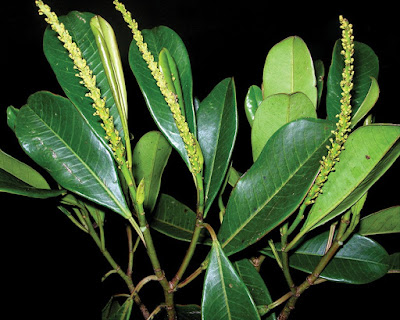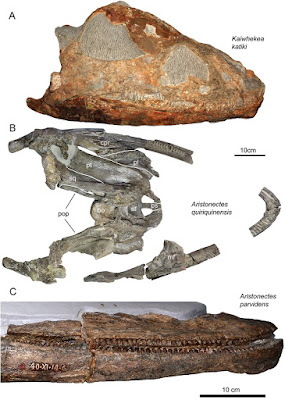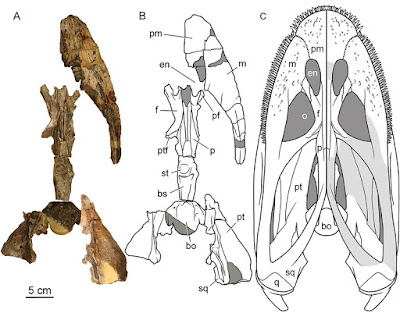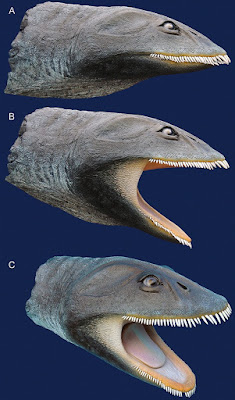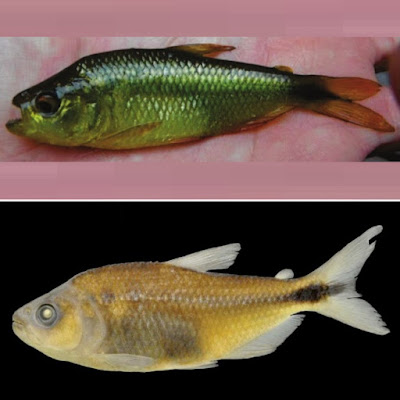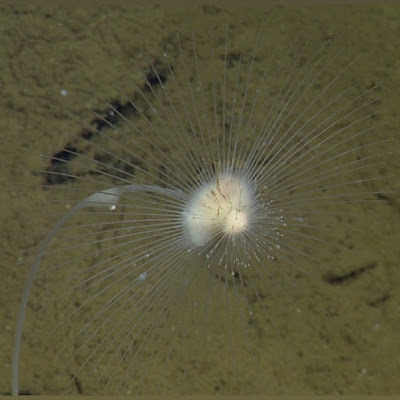[Most Recent Entries] [Calendar View]
Monday, September 4th, 2017
| Time | Event | ||||
| 8:52a | [Botany • 2017] Incadendron esseri • A New Genus of Euphorbiaceae tribe Hippomaneae from the sub-Andean cordilleras of Ecuador and Peru
Abstract Incadendron esseri K.Wurdack & Farfan, gen. et sp. nov., from the wet sub-Andean cordilleras of Ecuador (Cordillera del Cóndor) and Peru (Cusco, Oxapampa) is described and illustrated. This recently discovered large canopy tree with a narrow elevational range presents an unusual combination of rare morphological characters in Hippomaneae including mucilage-secreting sheathing stipules, conduplicate ptyxis, and large, woody fruits. The broader significance of these characters in Hippomaneae is discussed. The morphology and anatomy of Incadendron were investigated, highlighting its fruit similarities with Guiana Shield endemic Senefelderopsis, and the systematics value of ptyxis variation, which remains poorly studied for the family. Keywords: Anatomy, ecology, Euphorbiaceae, Hippomaneae, Incadendron, ptyxis, taxonomy Incadendron esseri K.Wurdack & Farfan, sp. nov. Diagnosis: Differs from other members of Euphorbiaceae by its combination of exudate of white latex, indument lacking; leaves coriaceous, with marginal glands, ptyxis conduplicate; stipules, large, sheathing, mucilage-secreting, deciduous; inflorescences leaf-opposed, spicate, with solitary pistillate flowers and numerous 3-flowered, glandular staminate cymules; flowers apetalous with 3 sepals, staminate flowers with 3 stamens; fruits large, woody, dehiscent; and seeds dry, ecarunculate. Etymology: The genus is combined from “Inca” (as Inka, Quechua for “ruler” or “lord”) referring to the indigenous Inca people and pre-Columbian empire that was centered in Cusco and encompassed much of the range of this taxon, and “dendron” (Greek) referring to tree, which is the habit of the plant. Some localities occur near the Trocha Unión, an ancient Inca path. The specific epithet is from “Esser”, the surname of Hans-Joachim Esser (Botanische Staatssammlung München, Germany) and honors this expert on Hippomaneae who has contributed much to our understanding of the tribe and Euphorbiaceae in general. Distribution, life history, and ecology: Incadendron is known from three well-separated clusters of localities (hereafter referred to as Cóndor, Manu, and Oxapampa populations) on the eastern slopes of the main Andean mountain range in Peru and Ecuador, where it occurs in wet montane forests at 1800–2400 m elevation (Fig. 2). The extent of discontinuity in its range is presently unclear due to the floristically poorly known nature of the intervening areas, and it should be looked for in similar habitats between the three populations. There are minor vegetative differences including leaf apex variation with most tips distinctly acute versus more rarely rounded (i.e., Neill & Kajekai 16620, Monteagudo et al. 16929), and a larger-leafed collection (i.e., Monteagudo et al. 4458). The differences exist within the populations and presently do not suggest differentiation worthy of taxonomic recognition. .... Kenneth J. Wurdack and William Farfan-Rios. 2017. Incadendron: A New Genus of Euphorbiaceae tribe Hippomaneae from the sub-Andean cordilleras of Ecuador and Peru. PhytoKeys. 85: 69-86. DOI: 10.3897/phytokeys.85.14757 | ||||
| 9:24a | [Paleontology • 2017] Cranial Anatomy of Morturneria seymourensis from Antarctica, and the Evolution of Filter Feeding in Plesiosaurs of the Austral Late Cretaceous
ABSTRACT This paper redescribes the holotype skull of the aristonectine elasmosaur Morturneria seymourensis from the upper Maastrichtian of Seymour Island, Antarctica. This description supports the validity of the genus Morturneria, distinct from the genus Aristonectes from Chile and Argentina. The paroccipital process of Morturneria is plesiomorphic, similar to Alexandronectes and unlike the autapomorphic occiput of Aristonectes. The palate of Morturneria is autapomorphic in possessing a strongly developed midline keel. The cranium of Morturneria is about 60% complete and preserves the anterior skull roof and palate; both regions were previously unknown in any aristonectine. The combination of the Morturneria holotype and recent research on other aristonectines allows the first confident cranial reconstruction of an aristonectine elasmosaur. The cranial anatomy of both Morturneria and its close relatives is derived relative to all other plesiosaurs, possessing a novel suite of dental and oral cavity adaptions. The suspensorium extends far behind the occipital condyle, and the jaw is long and hoop-like; together these features allowed a large gape and oral cavity volume. The palate of Morturneria is strongly keeled, forming arched lateral oral chambers that further increased oral cavity volume. The dentition of Morturneria is similar to that of Aristonectes, and all share autapomorphic interlocking combs of needle-like teeth that occluded outside the mouth and did not meet tip to tip. The upper and lower dentition formed an oral battery that may have functioned like a sieve in straining food particles from substrate ejected from the oral cavity. We theorize that this highly derived suite of adaptations is convergent with extant gray whales and archaic mysticetes and hypothesize that it functioned similarly in sieve feeding following suction. This is the first identification of whale-like filter feeding in any marine reptile, a condition once claimed to be anatomically impossible. F. Robin O'Keefe, Rodrigo A. Otero, Sergio Soto-Acuña, Jose P. O'gorman, Stephen J. Godfrey and Sankar Chatterjee. 2017. Cranial Anatomy of Morturneria seymourensis from Antarctica, and the Evolution of Filter Feeding in Plesiosaurs of the Austral Late Cretaceous. Journal of Vertebrate Paleontology. DOI: 10.1080/02724634.2017.1347570 Plesiosaur fossil found 33 years ago yields new convergent evolution findings http://phy.so/423466634 via @physorg_com | ||||
| 9:29a | [Ichthyology • 2017] Astyanax dolinae • A New Species of Astyanax (Characiformes: Characidae) from Dolina Água Milagrosa, Rio Paraguai Basin, Mato Grosso, Brazil
Abstract A new species of Astyanax is described from the upper Rio Paraguai basin, Mato Grosso State, Brazil. The new species can be distinguished from congeners by having the body intensely yellowish in life (v. silvery, reddish or lightly yellow) and by morphometric and meristics traits. Astyanax dolinae n. sp. cannot be assigned to any of the Astyanax species complex currently recognized for the genus. It is only known from the Dolina Água Milagrosa, a karstic sinkhole lake, entirely fed by groundwater, surrounded by Cerrado, the savannah-like vegetation of central South America. Key words: endemism; karstic sinkhole; Neotropical region; Río de La Plata; taxonomy. Astyanax dolinae sp. nov. Etymology: The specific name dolinae is in reference to the type-locality Dolina Água Milagrosa, Cáceres, Mato Grosso, Brazil. An adjective. W.J. da Graça, C.A.M. Oliveira, F.C.T. Lima, H.P. da Silva and I.M. Fernandes. 2017. A New Species of Astyanax (Characiformes: Characidae) from Dolina Água Milagrosa, Rio Paraguai basin, Mato Grosso, Brazil. Journal of Fish Biology. DOI: 10.1111/jfb.13405 | ||||
| 11:12a | [Porifera • 2017] Three New Species of Cladorhiza (Demospongiae, Poecilosclerida, Cladorhizidae) from the Northeast Pacific Ocean
Abstract Carnivorous feeding among the Cladorhizidae (Porifera, Demospongiae, Poecilosclerida) was first documented in 1995. Since that time, 161 species have been described and are currently recognized in 9 genera. Cladorhiza is the most speciose genus with a global, deep-water distribution of 41 species. Here we describe three new Cladorhiza species of ‘crinorhiza’ form from the Northeast Pacific Ocean off California, USA, and the Gulf of California, Mexico, from depths of 2472–4100m. In total, 11 specimens were collected between 1969 and 2015. Video recordings from remotely operated vehicles yield additional information on habitat type, geographic distribution, and abundance for some of these species. Keywords: Porifera, Cladorhizidae, Cladorhiza, deep-sea
Cladorhiza mexicana sp. nov. Type locality. Alarcon Rise, Gulf of California, Mexico. Etymology. The species name, mexicana, alludes to the country where the holotype was discovered. Diagnosis. Crinorhiza form, parasol-shaped sponge, on long stalk and presumed basal holdfast. Three size classes of megasclere styles and three microsclere categories including tridentate unguiferate anisochelae, contort sigmancistras, and asymmetrical pseudoamphiasters. Cladorhiza hubbsi p. nov. Etymology. Named in honor of Dr. Carl Leavitt Hubbs, renowned ichthyologist who studied both freshwater and marine fishes and had a keen interest in zoogeography, biology, hybridization, taxonomy, ocean temperature paleo-history, and more. Dr. Hubbs had an amazingly productive career, with nearly 712 publications to his credit with considerable emphasis placed on educating the public and actively promoting conservation. Diagnosis. Crinorhiza form, very conical, parasol-shaped sponge, on stalk of unknown true length. Three size classes of megasclere styles and three microsclere categories including tridentate unguiferate anisochelae, contort sigmancistra, and pseudoamphiaster. Cladorhiza kensmithi sp. nov. Etymology. Named in honor of Dr. Kenneth L. Smith Jr. for contributions to marine biology and ecology over the course of a more than 40-year career in which he has devoted much of his expertise to studying extreme habitats, including the deep sea and polar regions, and the impacts of a changing climate on these ecosystems. Diagnosis. Crinorhiza form, parasol-shaped sponge, on long stalk with densely branching rhizoid. Two to four apical spermatocyst-bearing discs on short, slender stalks. Four size classes of megasclere styles including rare strongyles and two microsclere categories including tridentate unguiferate anisochelae and contort sigmancistra Lonny Lundsten, Henry M. Reiswig and William C. Austin. 2017. Three New Species of Cladorhiza (Demospongiae, Poecilosclerida, Cladorhizidae) from the Northeast Pacific Ocean. Zootaxa. 4317(2); 247–260. DOI: 10.11646/zootaxa.4317.2.3 |
| << Previous Day |
2017/09/04 [Calendar] |
Next Day >> |
